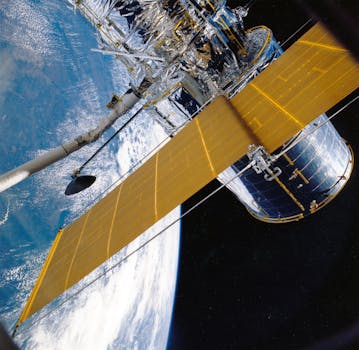
From Ground to Sky: The Evolution of Satellite Telecommunications Technology
From Ground to Sky: The Evolution of Satellite Telecommunications Technology has been a remarkable journey. The evolution of satellite telecommunications technology has transformed the way we communicate, from its humble beginnings to its current state-of-the-art advancements. Satellite telecommunications technology has come a long way since the launch of the first artificial satellite, Sputnik, in 1957. Today, satellite technology plays a vital role in global communications, providing connectivity to remote and underserved areas, and enabling a wide range of applications, including television broadcasting, navigation, and weather forecasting.
The first commercial satellite, Intelsat 1, was launched in 1965, marking the beginning of the satellite telecommunications era. This was followed by the launch of other notable satellites, such as Telstar and Molniya, which further expanded the capabilities of satellite communications. The 1970s and 1980s saw significant advancements in satellite technology, with the introduction of geostationary satellites, which enabled continuous coverage of a specific region, and the development of satellite-based navigation systems, such as GPS.
The Evolution of Satellite Technology
The evolution of satellite technology has been driven by advances in materials, electronics, and computing power. The development of new materials, such as lightweight composites and advanced propulsion systems, has enabled the creation of more efficient and capable satellites. The introduction of digital signal processing and compression has also improved the quality and capacity of satellite communications. Furthermore, the use of advanced computer systems and software has enabled the automation of many satellite functions, reducing the need for human intervention and increasing overall system reliability.
One of the most significant advancements in satellite technology has been the development of high-throughput satellites (HTS). HTS satellites use advanced technologies, such as spot beams and frequency reuse, to provide high-speed broadband connectivity to a large number of users. This has enabled the widespread adoption of satellite-based broadband services, particularly in areas where traditional terrestrial infrastructure is limited or non-existent.
Applications of Satellite Telecommunications Technology
Satellite telecommunications technology has a wide range of applications, including television broadcasting, navigation, weather forecasting, and remote sensing. Satellite television broadcasting has become a popular means of entertainment, with many channels available globally. Satellite navigation systems, such as GPS, have revolutionized the way we navigate, providing accurate location information and timing signals. Weather forecasting has also been improved significantly, with satellites providing high-resolution images of weather patterns and enabling more accurate predictions.
Remote sensing is another important application of satellite technology, enabling the collection of data on the environment, climate, and natural resources. Satellites can be used to monitor deforestation, track ocean currents, and detect natural disasters, such as earthquakes and hurricanes. This information can be used to inform policy decisions, support disaster response efforts, and promote sustainable development.
Challenges and Future Developments
Despite the many advancements in satellite telecommunications technology, there are still several challenges to be addressed. One of the main challenges is the issue of spectrum scarcity, with the increasing demand for satellite services putting pressure on available frequency bands. Another challenge is the need for improved security, with the risk of cyber attacks and data breaches posing a significant threat to satellite communications.
Looking to the future, there are many exciting developments on the horizon. The advent of 5G networks is expected to drive further growth in satellite communications, with the need for high-speed, low-latency connectivity driving demand for satellite-based services. The development of new satellite constellations, such as OneWeb and Starlink, is also expected to provide high-speed broadband connectivity to underserved areas, promoting digital inclusion and bridging the connectivity gap.



